英语课堂纠错技巧
如何在大学英语课堂中有效纠错
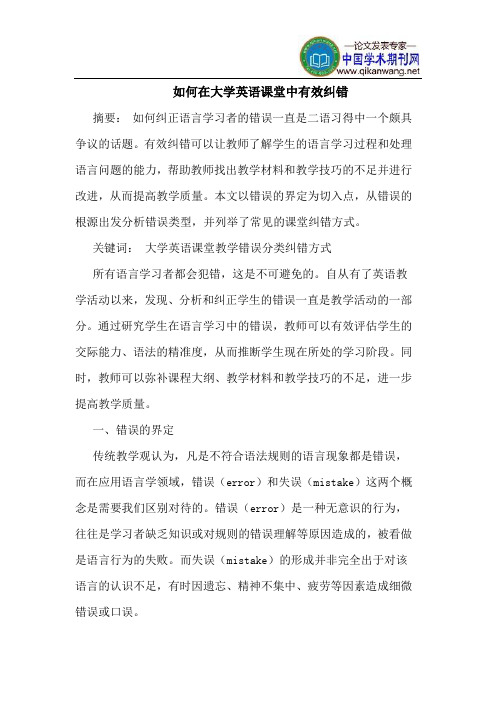
如何在大学英语课堂中有效纠错摘要:如何纠正语言学习者的错误一直是二语习得中一个颇具争议的话题。
有效纠错可以让教师了解学生的语言学习过程和处理语言问题的能力,帮助教师找出教学材料和教学技巧的不足并进行改进,从而提高教学质量。
本文以错误的界定为切入点,从错误的根源出发分析错误类型,并列举了常见的课堂纠错方式。
关键词:大学英语课堂教学错误分类纠错方式所有语言学习者都会犯错,这是不可避免的。
自从有了英语教学活动以来,发现、分析和纠正学生的错误一直是教学活动的一部分。
通过研究学生在语言学习中的错误,教师可以有效评估学生的交际能力、语法的精准度,从而推断学生现在所处的学习阶段。
同时,教师可以弥补课程大纲、教学材料和教学技巧的不足,进一步提高教学质量。
一、错误的界定传统教学观认为,凡是不符合语法规则的语言现象都是错误,而在应用语言学领域,错误(error)和失误(mistake)这两个概念是需要我们区别对待的。
错误(error)是一种无意识的行为,往往是学习者缺乏知识或对规则的错误理解等原因造成的,被看做是语言行为的失败。
而失误(mistake)的形成并非完全出于对该语言的认识不足,有时因遗忘、精神不集中、疲劳等因素造成细微错误或口误。
二、错误的分类1.迁移性错误(transfer error)。
它是指由于母语负迁移的干扰使学习者套用母语的结构或用法等而产生的错误。
当学生想表达的内容超过了他目前所掌握的新语言范围时,就会自然而然地套用母语语言规则。
例如中国学生习惯性地将“好好学习,天天向上”(work hard and make progress everyday.)翻译为good good study,day day up.2.类推性错误(analogical error)。
它是指对学习者对目标语规则的过度归纳或进行无限制的类推造成的错误。
最为典型的表现在名词的单复数和动词的过去式、过去分词的变形上。
例如将名词man,foot,mouse的复数形式(men,feet,mice)变成mans,foots,mousse;将动词drink,run,give的过去式(drank,ran,gave)变为drinked,runed,gived。
浅谈高职英语课堂教学中的纠错技巧
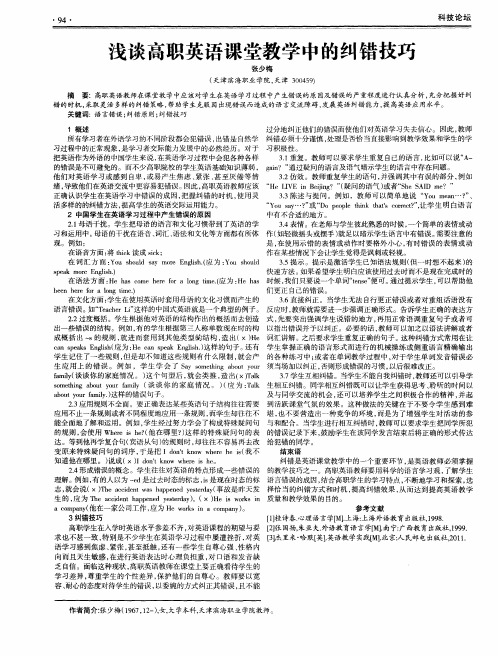
9 4・
科 技 论 坛
浅谈பைடு நூலகம்高职英语课堂教 学 中的纠错技巧
张 少 梅
( 天津滨海职业学院, 天津 3 0 0 4 5 9 )
摘 要:高职英语教师在课 堂教 学中应该对学生在英语 学习过程 中产生错误 的原 因及错误的严重程度进行认真分析 , 充分把握好纠 错的时机 , 采取灵活 多样 的纠错策略 , 帮助 学生克服 因出现错误而造成的语言交流障碍 , 发展 英语 纠错 能力 , 提 高英语应用水平。 关键词: 语言错误 ; 纠错原则 ; 纠 错 技 巧
过分地纠正他们 的错误 而使他们对英语学 习失去信心 。因此 , 教师 所有学习者在外语学习的不同阶段都 会犯 错误 , 出错是 自然学 纠错必须十分谨慎 , 处理是否恰当直接影响到教学效果和学生的学 习过程 中的正常现象 , 是 学习者交 际能力发展 中的必然经历 。对于 习积 极 性 。 3 . 1 重复 。教师可 以要求学生重复 自己的语言 , 比如可以说“ A — 把英语作为外语的中国学生来说 , 在英语学 习过程 中会犯各种各样 的错误是不可避免的。而不少高职院校的学生英语基础知识薄弱 , g a i n ?” 通过疑问的语言及 语气 暗示学生的语言中存 在问题 。 他们对 英语学 习或感 到 自卑 , 或 易产 生焦虑 、 紧张 、 甚至厌 倦等情 3 . 2仿效。教师重复学生的语句 , 并强 调其 中有误的部分 , 例如 绪, 导致他们在英语交流中更容易犯错误。 因此 , 高职英语教师应该 “ H e L I V E i n B e i j i n g ?” ( 疑问的语气 ) 或者“ S h e S A I D m e ?” 正确认 识学生在英语学习 中错误 的成 因 , 把握 纠错 的时机 , 使用灵 3 . 3陈述 与提问 。例如 ,教师可 以简单地 说 “ Y o u me a n …? ’ ’ 、 活多样的的纠错方法 , 提高学生 的英语交际运用能力。 “ Y o u s a y …? ” 或“ D o p e o p l e t h i n k t h a t ’ s c o r r e c t ? ” , 让学 生明 白语言 2 中 国学 生 在 英 语 学 习过 程 中产 生错 误 的原 因 中有不合适的地方。 2 . 1 母语干扰 。学生把母 语的语 言和文化习惯带 到了英语 的学 3 . 4表情。在老师与学生彼此熟悉的时候 , 一个简单的表情 或动 习和运用中 。 母语的干扰在语音 、 词汇 、 语法 和文化等方面都有 所体 作 ( 如轻微摇头或摆手 ) 就足以暗示学生语言中有错误 。 需要注 意的 现。例如 : 是, 在 使用 示错的表情或动作 时要格外小心 , 有时错误 的表情或 动 在语音方面 : 将t h i c k读成 s i c k ; 作 在某些情况下会让学生觉得是讽刺或轻视 。 在 词 汇方 面 : Y o u s h o u l d s a y m o r e E n g l i s h . ( 应为 : Y o u s h o u l d 3 . 5提示 。提示是激活学生 已知语法规则 ( 但一 时想 不起来 ) 的 快速方法 。 如果希望学生明 白应该使用过去 时而不是现在完成时的 s p e a k m o r e E n g l i s h . ) 在 语法方 面 : He h a s c o me h e r e f o r a l o n g t i m e . f 应为 : H e h a s 时候 , 我们只要说一个单词 “ t e n s e ” 便可 。 通过提示 学生 , 可 以帮助他 b e e n h e r e f o r a l o n g t i me . ) 们 更正 自己的错误 。 在文化方面 : 学生在使用英语时套用母语的文化习惯而产生的 3 . 6直接纠正 。当学生无法 自行更正错误 或者对重组话语 没有 语言错误 。 如“ T e a c h e r L i ” 这样的中国式英语就是一个典型的例子。 反应时 , 教师就需要 进一步强调正确形式 。告诉 学生 正确 的表达方 2 . 2过度概括。学生根据他对英语的结构作 出的概括而去创造 式 , 先 要突出强调学生说错 的地方 , 再用正常语调重 复句子或 者可 出一些错误 的结构。例如 , 有 的学生根据第 三人称单数现在时的构 以指出错误并予 以纠正。必要的话 , 教师可 以加之 以语法讲解 或者 成概括 出 一 S 的规则 , 就进而套用 到其他类 型 的结 构 , 造 出( ×) H e 词汇讲解 。之后要求学生重 复正确 的句子 。 这种 纠错方式常用在让 c a n s p e a k s E n g l i s h ( 应为 : He e a i ' l s p e a k E n l g i s h . ) 这样的句子 。 还有 学生掌握正 确的语言形式而进行 的机械操练或侧 重语言精确 输 出 学生记住 了一些规 则 , 但是却不 知道 这些规则有什 么限制 , 就会产 的各种练 习中 ; 或 者在 单词教学过程 中 , 对于学生单 词发音错 误必 生 应用 上 的错 误 。例 如 ,学 生学 会 了 S a y s o m e t h i n g a b o u t y o u r 须 当场加以纠正 , 否则形 成错误 的习惯 , 以后很难改正 。 f a mi l y ( 谈谈 你的家庭情 况 。) 这个 句型后 , 就会 类推 , 造 出f x) T a l k 3 . 7 学生互相纠错。当学生不能 自我 纠错时 , 教师还可 以引导学 s o me t h i n g a b o u t y o u r f a m i l y( 谈 谈 你 的 家庭 情 况 。 ) ( 应 为: T a l k 生相互纠错 。同学相互纠错既可 以让学生获得思考 、 聆听的时间 以 a b o u t y o u r f a mi l y . ) 这样 的错误句子。 及与 同学交 流的机会 , 还可 以培养学生之 间积极合作 的精 神 , 并起 2 . 3 应用规则不全面。要 正确表达某些英语句子结构往往需要 到 活跃课 堂气氛 的效果 。这种做法 的关键在于不要 令学生感 到难 应用不止一 条规则或者不 同程度地应用一条规则 , 而学生却往往不 堪 , 也不要营造 出一种 竞争的环境 , 而是为 了增强学 生对活动 的参 能全面地了解 和运用 。例如 , 学生经过努力学会 了构成特殊疑 问句 与和配合。当学生进行相互纠错时 , 教师可以要求学生把 同学所犯 的规则 , 会使 用 Wh e r e i s h e ? ( 他在 哪里? ) 这样 的特殊疑 问句 的表 的错误记录下来 , 鼓励学生在该同学发言结束后将正确的形式传达 达 。等到他再学 复合句 ( 宾语 从句 ) 的规则时 , 却往往 不容易再 去改 给犯错 的同学 。 变 原来特殊疑 问句的词序 , 于是把 I d o n t k n o w w h e r e h e i s ( 我不 结束 语 知道他在哪里。 ) 说成( ×) I d o n ’ t k n o w w h e r e i s h e 。 纠错是英语课堂教学 中的一个重要环 节 , 是英语 教师必须掌握 2 . 4 形 成错误 的概念 。学生往往对英语 的特 点形 成一些错误 的 的教学技巧之一 。高职英语教 师要用科学 的语言 学习观 , 了解学生 理解 。 例如 , 有 的人 以为 一 e d 是 过去时态 的标志 , i s 是现在时态的标 语 言错误的成因 , 结合高职学生的学习特点 , 不断地学 习和探索 , 选 志, 就会说( ×) T h e a c c i d e n t w a s h a p p e n e d y e s t e r d a y ( 事故是昨天发 择恰 当的纠错方式和 时机 , 提高 纠错效果 , 从 而达到提高英语 教学 生的 , 应为 T h e a c c i d e n t h a p p e n e d y e s t e r d a y ) ,( ×) H e i s w o r k s i n 质量和教学效果的 目的。 a c o m p a n y ( 他在一家公 司工作 , 应为 H e w o r k s i n a c o m p a n v o 参考文献 3纠错技巧 f 1 ] 桂诗春. 心理语 言g E M ] . 上 海: 上海外语教育 出版社, 1 9 9 8 . 高职学生在入学时英语水平参差不齐 , 对英 语课 程的期望 与要 【 2 ] 张 国扬' 朱亚夫. 外语教 育语 言学[ M】 . 南宁: 广西教育 出版社, 1 9 9 9 . 求也不甚一致 , 特别是不少学生在英语 学习过程 中屡遭 挫折 . 对英 【 3 1 杰里米 ・ 哈默【 英1 . 英语教学实践[ M I 北京: 人 民邮 电出版社, 2 0 1 1 . 语学习感到焦虑 、 紧张 , 甚至抵触 , 还有一些学生 自尊心 强 、 性 格 内 向而且天生敏感 , 在进行英语表 达时心理负担重 , 对 口语 和发 音缺
英语课堂上的纠错艺术
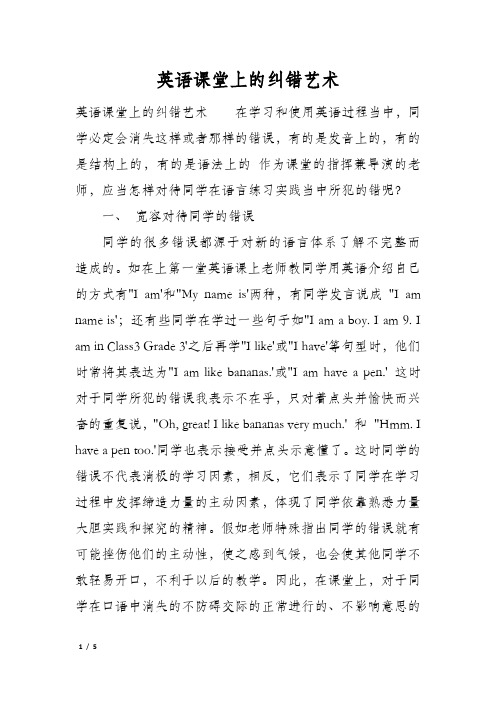
英语课堂上的纠错艺术英语课堂上的纠错艺术在学习和使用英语过程当中,同学必定会消失这样或者那样的错误,有的是发音上的,有的是结构上的,有的是语法上的作为课堂的指挥兼导演的老师,应当怎样对待同学在语言练习实践当中所犯的错呢?一、宽容对待同学的错误同学的很多错误都源于对新的语言体系了解不完整而造成的。
如在上第一堂英语课上老师教同学用英语介绍自己的方式有"I am'和"My name is'两种,有同学发言说成"I am name is';还有些同学在学过一些句子如"I am a boy. I am 9. I am in Class3 Grade 3'之后再学"I like'或"I have'等句型时,他们时常将其表达为"I am like bananas.'或"I am have a pen.' 这时对于同学所犯的错误我表示不在乎,只对着点头并愉快而兴奋的重复说,"Oh, great! I like bananas very much.' 和"Hmm. I have a pen too.'同学也表示接受并点头示意懂了。
这时同学的错误不代表消极的学习因素,相反,它们表示了同学在学习过程中发挥缔造力量的主动因素,体现了同学依靠熟悉力量大胆实践和探究的精神。
假如老师特殊指出同学的错误就有可能挫伤他们的主动性,使之感到气馁,也会使其他同学不敢轻易开口,不利于以后的教学。
因此,在课堂上,对于同学在口语中消失的不防碍交际的正常进行的、不影响意思的完整表达的、或在以后语言积累中可以自行改正的错误,老师应以科学的、宽容的态度对待。
二、恰当订正同学的错误随着英语学习的深入到,英语句型越来越多,在学习了新的语言项目,进行机械性操练阶段如替换练习、语言语法专项练习等,同学所犯的错误应当赐予恰当的订正。
初中英语课堂教师纠错方法

初中英语课堂教师纠错方法前一种态度容易致使学生学习心理的松懈导致错误顽固化,后一种态度往往容易导致学生应过多的“被纠正”而逐渐丧失学习自信心。
对于初中英语课堂纠错行为而言,我们首先要对错误进展定位,对于学生因对语言信息的不理解导致交流和表达上的错误。
应及时予以重点纠正;对于不阻碍学生理解,只牵涉到句子的一部分,如词汇、语调的发音不正确,或是某个语法错误,对于这些错误,我们不应抓着不放,可以让学生自主纠错。
在纠错手段上,我们教师大多喜欢直接指出学生出错点,这种在课堂上直接的纠错行为,虽然意义明确,不过对于自尊心比较强的学生而言往往弊大于利,长期下去,这部分学生会对师生互动、交流对话产生焦虑感,甚至会形成抵触情绪,直接构成对学生英语成绩的影响。
随着新课程的深化,我们教师除了关注教学内容以外,也开始关注学生的学习心理和情感,间接纠错方式越来越多地应用到课堂教学之中与直接纠错配合起来应用,与直接纠错相比,在学生语言学习出现错误时。
知道正确表述和答案的教师不直接予以纠正,而是采用追问、扩展句子,或教师重述学生的错误句段,或将正确的语言形式通过加重语气、变化语调等等形式进展表达,借此引发学生的注意,这是一种间接的示范提醒,出错的学生很自然地进展自我比对,掌握正确的语言形式,这种做法是一种礼貌的和尊重学生情感的纠错方法。
例如,笔者有一次在和学生对话时,学生先出现了错误。
T:WhatdidyoudolastSunday?S:Igotothezoo.对于学生这个语法应用上的错误,笔者没有直接纠正,而是进一步扩展。
T:Iwenttothezoo.Whatdidyoudoyesterday?S:Ididmyhomework.从学生的答复,我可以确定学生意识到了自己的错误并在我的引导下自主纠正了错误,最后,我给了一个评价:“Thatisright.”这样的纠错方式学生的情感得到了充分的保护,而且其自己从出错到正确,有一种语言习得的满足感,这样的纠错方式使学生有效地翻开了学生的情感,更乐意承受教师纠错。
英语课堂纠错方法纠错策略在英语课堂教学中的应用

英语课堂纠错方法纠错策略在英语课堂教学中的应用在英语课堂教学中,学生常常为学习过程中出现的语言错误所困扰。
为了摆脱这种困扰,提高教学质量,英语教师及广大语言学家进行了大量的比较、分析、预测、纠错的工作。
然而,在外语教学中,学生语言错误依然存在。
作为教学一线的英语教师对于课堂教学中学生出现的错误是否纠正、何时纠正、如何纠正、纠正哪些错误以及由谁来纠正,这些都是值得我们认真思考的问题。
一、纠错策略中值得思考的问题1.是否应该纠正学习者的错误任何人的输出语都有可能成为其他人的输入语,错误形式也可能成为别人的输入语。
如果学生出了错误而教师对错误不进行处理的话,那么其他学可能会把错误形式误当作正确形式而吸收。
因此大多数学生希望教师对错误予以纠正,但作为教师在决定是否纠错之前,应该充分考虑到学生的个性特点、错误的性质、课堂气氛、学生的接受能力等多种因素。
2.何时纠正学习者的错误当教师决定要纠正学生的错误时,还要考虑纠错的最佳时机。
从纠错的时间上来看,纠错有两种形式即及时纠错和延时纠错。
及时纠错,能够让学习者更好地理解所犯错误的情境,在真实的语境中更方便学生对正确信息的理解和吸收。
但及时纠错有可能使犯错的学生在同学面前感到尴尬、会打断流利性活动的进行、纠错过多还会抑制学生在课堂中发言的意愿从而影响课堂气氛。
延时纠错虽然保障了课堂教学的顺利进行但如果纠错的时间与错误发生的时间间隔过久势必影响纠错的效果,由于缺乏真实的语境,给学生对错误的认识增加了难度。
因此教师要根据学生出错的具体情况选择适合的纠错方式。
3.需要纠正学习者的哪些错误目前按照学习者语言系统的形成进程,把错误划分为前系统性错误、系统性错误和后系统性错误。
前系统性错误是指学习者不了解目标语规则情况下犯的错误;系统性错误是指学习者了解目标语规则,只不过它是一个错误规则;后系统性错误是指学习者了解目标语规则,但不能准确使用。
针对不同的错误类型,教师应该采取不同的方式对待学生的错误。
英语课堂教学中的纠错艺术
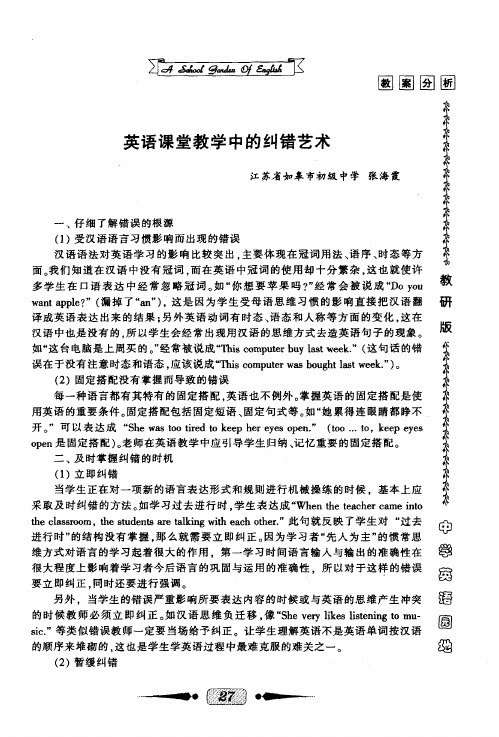
oe pn是 固定 搭 配 )老 师在 英 语 教 学 中应 引导 学 生 归 纳 、 忆 重 要 的 固定 搭 配 。 。 记 二 、 时掌 握 纠 错 的 时 机 及
进 行 时 ” 结 构 没 有 掌 握 , 么 就 需 要 立 即纠 正 。 为 学 习者 “ 人 为 主 ” 惯 常 思 的 那 因 先 的
维 方 式 对 语 言 的学 习起 着 很 大 的 作 用 ,第 一学 习时 间语 言 输 入 与 输 出 的准 确 性 在 很 大 程 度 上 影 响 着学 习者 今 后 语 言 的 巩 固 与运 用 的 准确 性 。所 以对 于 这 样 的错 误 要 立 即纠 正 , 同时 还 要 进行 强 调 。
( )立 即 纠错 1
当学 生 正 在 对一 项 新 的语 言 表 达 形 式 和 规 则进 行 机 械 操 练 的 时候 ,基 本 上 应 采 取 及 时纠 错 的方 法 。 学 习 过去 进行 时 , 生 表 达成 “ e etahr al it 如 学 Wh nt ce ne no h e c tec sro tes d n e a ig i ahohr h l s m, u et a l n t ec te. 句就 反 映 了学 生 对 “ 去 a o h t s r tk w h ”此 过
另 外 ,当学 生 的错 误 严 重影 响所 要 表 达 内容 的 时候 或 与 英 语 的思 维 产 生 冲 突 的 时 候 教 师 必 须 立 即 纠 正 。 汉 语 思 维 负 迁 移 , “h eyl e s nn . 如 像 S evr k s ie i t mu i lt g o s . 类 似 错 误 教 师 一定 要 当场 给 予 纠 正 。让 学 生 理 解英 语 不 是 英 语 单 词 按 汉 语 i ”等 c
如何把握英语课堂口语纠错的时机

如何把握英语课堂口语纠错的时机如何把握英语课堂口语纠错的时机全部同学在学习语言的不同阶段都会犯错误。
在教学中,我发觉同学在与同学或老师相互沟通时会消失很多错误,有时他们说出来的话难于理解,直接导致交际失败。
同学的口语错误既有语音、语法层面的,也有语用层面的。
有的错误是受到母语迁移的影响,有的错误是源于语言学习的认知过程。
很多时候,我想即时订正同学在口语表达中所犯的错误,但又怕打击他们口语相互沟通的主动性、损害他们的自尊、影响他们表达的流利性。
但是假如听之任之、不即时订正,又怕同学不断地加深错误,形成习惯。
因此,本学期中,我将同学在课堂上的口语错误进行分类,并分析其缘由,以便较好地选择和把握纠错的时机。
一、口语错误的类型1、失误与错误。
同学在与人相互沟通时由于记不清、紧急或疲惫造成的语言运用错误属于无规律的"失误',事后同学有力量识别和自己订正这类错误。
而"错误'是同学在某一阶段的语言力量,他们没有力量自行订正,这是有规律的。
我班同学在口语表达时既有"失误'这样的小错,也有"错误'这样的大错。
例如:在学习将来时态时,我请同学用英语描述伴侣一周的方案时,他们就消失了这两类错误。
(①表示失误,②表示错误。
)T: Who is your best friend ?S1: My best friend is Sarah.T: What ill she do next eek?S1: Next Monday, he (she①) ill play basketball. On Tuesday, she have (ill have①) a (an①) English class. On Wednesday, she ill clean shes (her②) room. On Thursday, she go shopping (ill go shopping①) . On Friday, she ill go home. On Saturday, she ill do shes (her②) homeork. On Sunday, she make (ill make①) hamburger (hamburgers①).2、全局性错误与局部性错误全局性错误是指影响了整个句子结构,导致句子或话语意思难于理解,以致影响交际进行的错误。
高中英语课堂纠错方法
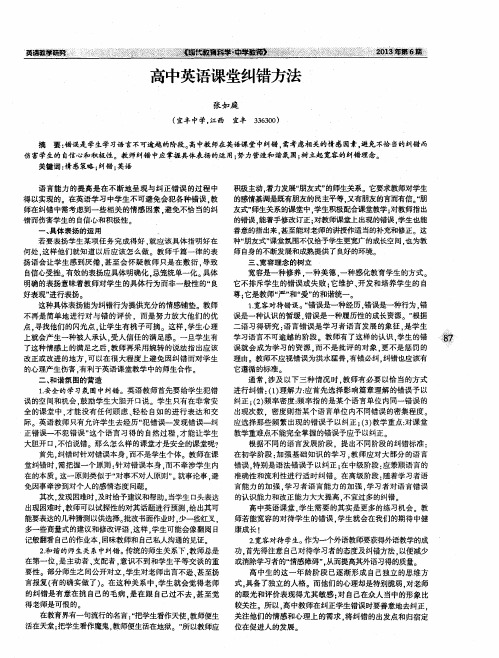
研 。
1 ' 舔
6 错
高中英语课堂纠错方法
张如 庭
( 宜丰中学, 江西 摘 宜丰 3 3 6 3 0 0 )
要: 错误是学生学习语 言不可逾越 的阶段 。 高 中教 师在英语课 堂中纠错 , 需考虑相关的情感 因素 , 避免不恰 当的纠错而
伤 害学生的 自信心和积极性。教师纠错 中应 掌握具体表扬 的运 用; 努力营造和谐氛围 ; 树立起 宽容 的纠错理念。 关键词 : 情感策略 ; 纠错 ; 英语 语言能力 的提 高是在不 断地呈现 与纠正错误 的过程 中
积极主动 。 着力发展“ 朋友式 ” 的师生关系。它要求教师对学生 的感情基调是既有朋友的民主平等, 又有朋友的言而有信。 “ 朋 友式” 师生关系的课堂中 。 学生积极配合课堂教学 ; 对教师指 出
的错误 , 能着手修改订正; 对教师课堂上出现的错误 , 学生也能 善意的指 出来 。 甚至能对老师的讲授作适当的补充和修正。这师在 纠错 中需考虑到一些相关 的情感 因素 . 避免不恰 当的纠
错而伤害学生的 自信心和积极性 。
具 体 表 扬 的运 用 一 若要表扬学生某项任务完成得好 . 就 应 该 具 体 指 明好 在 何处 。 这样他们就知道 以后 应该怎么做 。教师千篇一律 的表
它遵循的标 准。 通常 , 涉及 以下三种 情况 时 。 教 师有 必要 以恰 当的方 式
进行 纠错 : ( 1 ) 理解 力: 应 首先选择影 响篇章 理解 的错误予 以 纠正 : ( 2 ) 频率密度: 频 率指的是某个语 言单 位内同一错误 的 出现次数 .密度则指某 个语言单位 内不同错误的密集程度 。 应选择那些频繁 出现 的错误 予 以纠正 : ( 3 ) 教学重点: 对课 堂 教学重难点不能完全掌握的错误予应予以纠正。
英语课堂中的纠错艺术
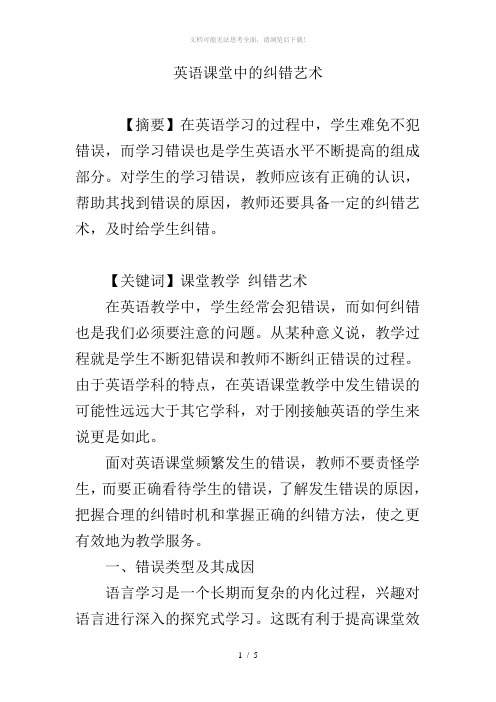
英语课堂中的纠错艺术【摘要】在英语学习的过程中,学生难免不犯错误,而学习错误也是学生英语水平不断提高的组成部分。
对学生的学习错误,教师应该有正确的认识,帮助其找到错误的原因,教师还要具备一定的纠错艺术,及时给学生纠错。
【关键词】课堂教学纠错艺术在英语教学中,学生经常会犯错误,而如何纠错也是我们必须要注意的问题。
从某种意义说,教学过程就是学生不断犯错误和教师不断纠正错误的过程。
由于英语学科的特点,在英语课堂教学中发生错误的可能性远远大于其它学科,对于刚接触英语的学生来说更是如此。
面对英语课堂频繁发生的错误,教师不要责怪学生,而要正确看待学生的错误,了解发生错误的原因,把握合理的纠错时机和掌握正确的纠错方法,使之更有效地为教学服务。
一、错误类型及其成因语言学习是一个长期而复杂的内化过程,兴趣对语言进行深入的探究式学习。
这既有利于提高课堂效率,也有利于让学生获得英语学习的成就感,逐步形成学习英语的兴趣,并使之成为其自主学习的动力。
不同的学习者在学习语言的过程中会犯不同的语言错误。
根据错误分析的研究成果(Brown,2002;Ellis,1 999;James,2001),学生所犯的错误主要有以下四种:1.语际错误。
英语课堂上学生所犯的错误多数是来于母语的负迁移造成的,这种错误就是语际错误。
在学习外语时,母语与外语相似或一致的内容要比不一致的内容更容易被学习者掌握。
母语的正迁移常因对外语学习起促进作用而使学习者受益;而母语的干扰则会产生负迁移,给学习者的外语学习带来困难(James,2001)。
在交际活动中,当学生难以在目的语中找到与母语中某种表达相对应的表达方式时,他们往往借助母语的表达形式或习惯来维持交际。
比如,汉语中常用主动句型表示被动含义,因而学生说出“The problem will discuss tomorrow.”的句子也就不足为奇了。
2.语内错误。
在第二语言学习过程中,因一个目的语项目对另一个项目产生影响而发生的错误叫语内错误。
英语课堂如何纠错
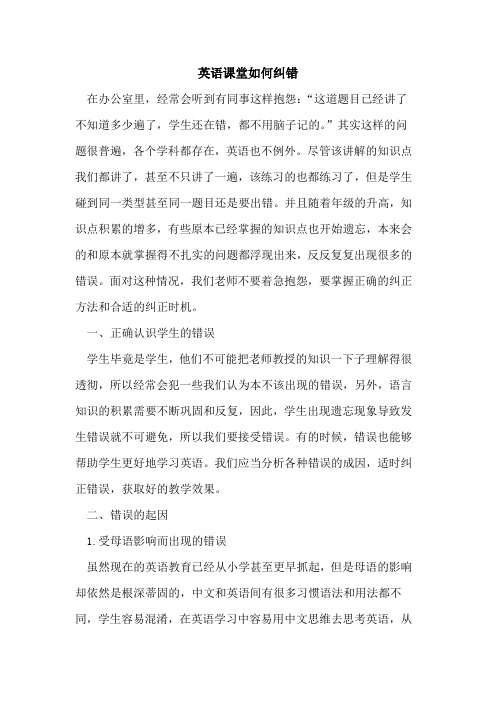
英语课堂如何纠错在办公室里,经常会听到有同事这样抱怨:“这道题目已经讲了不知道多少遍了,学生还在错,都不用脑子记的。
”其实这样的问题很普遍,各个学科都存在,英语也不例外。
尽管该讲解的知识点我们都讲了,甚至不只讲了一遍,该练习的也都练习了,但是学生碰到同一类型甚至同一题目还是要出错。
并且随着年级的升高,知识点积累的增多,有些原本已经掌握的知识点也开始遗忘,本来会的和原本就掌握得不扎实的问题都浮现出来,反反复复出现很多的错误。
面对这种情况,我们老师不要着急抱怨,要掌握正确的纠正方法和合适的纠正时机。
一、正确认识学生的错误学生毕竟是学生,他们不可能把老师教授的知识一下子理解得很透彻,所以经常会犯一些我们认为本不该出现的错误,另外,语言知识的积累需要不断巩固和反复,因此,学生出现遗忘现象导致发生错误就不可避免,所以我们要接受错误。
有的时候,错误也能够帮助学生更好地学习英语。
我们应当分析各种错误的成因,适时纠正错误,获取好的教学效果。
二、错误的起因1.受母语影响而出现的错误虽然现在的英语教育已经从小学甚至更早抓起,但是母语的影响却依然是根深蒂固的,中文和英语间有很多习惯语法和用法都不同,学生容易混淆,在英语学习中容易用中文思维去思考英语,从而导致出错。
例如,中文有的句子不存在被动语态一说,在表达“问题还没有解决”这句话时,学生根据中文考虑不到被动语态,往往说成:“the preblem haven’t solved.”便出现了语法错误。
再如,我们常说今天太热,中间并没有动词,而英文表述时,学生常常会据此表达成:today very hot.学生翻译句子或是讲述句子没有动词是经常发生的。
更经常的是学生容易发生三单动词错误,即使到了初三的学生还要出现,因为中文中不管是你、我、他,还是他们后面接的都是“是”,而英文中i 后面跟am,he后面跟is,they 后面跟are,所以学生很容易混淆出错。
2.错误类比导致的错误英语和其他语言一样有一定的语法规则和习惯表达,学生学了一定的语法规律后容易望文生义,错误类比。
英语课堂中的口语纠错技巧
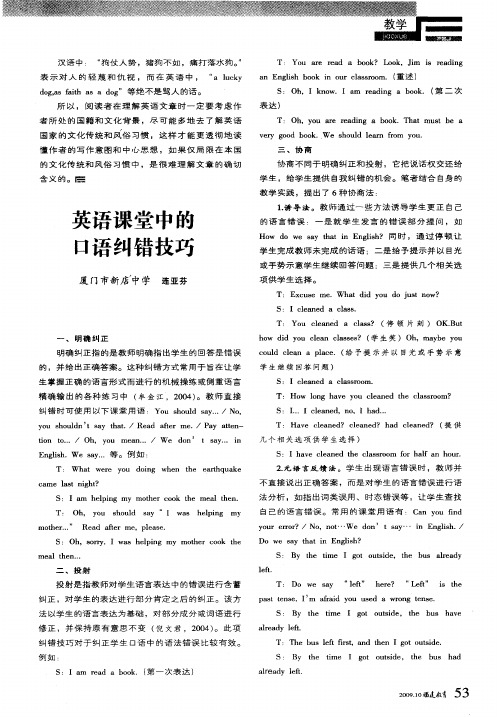
En l h gi .W e sy 等 。 例 如 : s a…
T : W ha we e o don whe t e e  ̄h a e t r y u ig n h a qu k c m e a t i t a l s ngh ? S: I m h l ng a epi my mohe o k h me l he t r c o t e a t n. T : Oh y u s o d s y “ 1 wa h l i g my , o h ul a s epn mohe … ” Re d fe e t r a a tr m ,pla e es.
含 义 的 。l 焘
三 、协 商
协 商 不 同 于 明确 纠 正和 投 射 , 它把 说 话 权 交还 给 学 生 ,给 学 生 提供 自我 纠错 的机 会 。 笔 者 结 合 自身 的 教 学 实 践 ,提 出了 6种 协 商 法 : 1诱 导 法 。教 师通 过 一 些 方法 诱 导 学 生 更 正 自 己 .
辫
翳
■●●● _ 一
汉语 中 : “ 仗 人 势 ,猪狗 不如 ,痛 打 落 水 狗 。 狗 ” 表 示 对 人 的 轻 蔑 和 仇 视 , 而 在 英 语 中 , “ lc y a u k d ga at s a d g o ,sfi a o ”等 绝 不 是 骂 人 的话 。 h
T : Yo a e e d b k? L o u r r a a oo o k, Jm i r di i s ea ng
a gih b o n o r ca so m. ( 述 ) n En l ok i u lsro s 重 S:Oh k o ,I n w.I m e dn a o k ( 二 次 a ra ig b o . 第
英语课堂教学中的常见错误及纠错对策

英语课堂教学中的常见错误及纠错对策作为教师,如何对待和纠正学生学习中出现的错误,会对学生的英语学习产生很大的影响。
纠错的次数、类型和方式将会直接影响教学效果。
教师在选择纠错方法时,除了要区别错误类型、性质和考虑教学目的外,还应该考虑与学习者相关的各种因素,如年龄、学龄、个性差异、语言水平、目前所处的学习阶段等。
对不同年龄、学龄的学习者,教师纠错的方法应有所不同。
同一学龄和年龄段的学习者,个性心理特征也各不相同,教师也应有选择地使用不同的纠错方法。
笔者结合自己多年的教学经验谈谈自己的看法。
一、具体情况具体对待,科学看待学生的错误教师要用科学的理论来指导学生纠错。
在平时的教学过程中,我们发现学生在口语表达上经常出现一些似是而非且顽固性语言错误。
针对这类问题,笔者认为每个错误的出现和解决都要经过收集、识别、描写、解释、评价和纠正几个过程。
因为在教学过程中学生不可能一下就完全掌握所学内容,他们必须要经历一个漫长的内化过程。
在这个过程中出现语言错误极为正常,所以我们无需对学生的错误产生困惑和不解。
另外,学生个体发展的差异也直接导致接受能力方面的差异。
比如,在同一个班级中有的学生语言表达方面的能力强一些,有的学生理解方面的能力强一些,即使同一个学生各方面的发展水平也会有所不同。
所以,教师要善待和关心出现错误的学生,仔细分析并适时纠正错误。
二、摆正心态,理清认识教师应该充分认识到学生的语言错误是学习英语过程中重要而又自然的组成部分,它为课后的辅导提供了重要依据。
对学生的错误持消极态度是不应该的,存在畏惧心理是没有必要的,对学生的错误持不可容忍、逢错必纠的态度也是不可取的。
在纠正学生的口语错误时,教师应注意保护他们的自尊心和自信心,多采取鼓励、重复和幽默等策略,切忌态度生硬、粗暴。
三、审时度势,把握纠错的时机在弄清学生错误发生的根源后,教师就要进行纠正,可到底是学生一犯错误就纠正,还是为了不打消其积极性而后续指正呢?关键要把握好纠错的时机,如果是在教师讲授某个语言点或句型的时候学生出错,则应该及时纠错,以保证语言学习的准确性,只有每一句的句法准确才能保证语段表达的准确。
中学英语课堂教学如何纠错
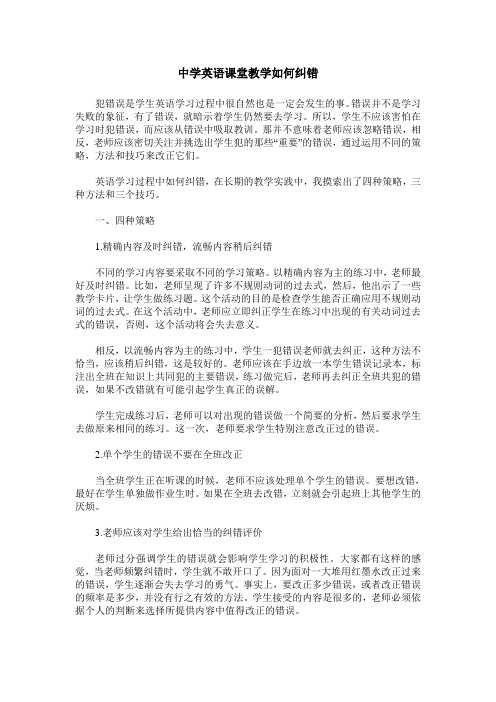
中学英语课堂教学如何纠错犯错误是学生英语学习过程中很自然也是一定会发生的事。
错误并不是学习失败的象征,有了错误,就暗示着学生仍然要去学习。
所以,学生不应该害怕在学习时犯错误,而应该从错误中吸取教训。
那并不意味着老师应该忽略错误,相反,老师应该密切关注并挑选出学生犯的那些“重要”的错误,通过运用不同的策略,方法和技巧来改正它们。
英语学习过程中如何纠错,在长期的教学实践中,我摸索出了四种策略,三种方法和三个技巧。
一、四种策略1.精确内容及时纠错,流畅内容稍后纠错不同的学习内容要采取不同的学习策略。
以精确内容为主的练习中,老师最好及时纠错。
比如,老师呈现了许多不规则动词的过去式,然后,他出示了一些教学卡片,让学生做练习题。
这个活动的目的是检查学生能否正确应用不规则动词的过去式。
在这个活动中,老师应立即纠正学生在练习中出现的有关动词过去式的错误,否则,这个活动将会失去意义。
相反,以流畅内容为主的练习中,学生一犯错误老师就去纠正,这种方法不恰当,应该稍后纠错,这是较好的。
老师应该在手边放一本学生错误记录本,标注出全班在知识上共同犯的主要错误,练习做完后,老师再去纠正全班共犯的错误,如果不改错就有可能引起学生真正的误解。
学生完成练习后,老师可以对出现的错误做一个简要的分析,然后要求学生去做原来相同的练习。
这一次,老师要求学生特别注意改正过的错误。
2.单个学生的错误不要在全班改正当全班学生正在听课的时候,老师不应该处理单个学生的错误。
要想改错,最好在学生单独做作业生时。
如果在全班去改错,立刻就会引起班上其他学生的厌烦。
3.老师应该对学生给出恰当的纠错评价老师过分强调学生的错误就会影响学生学习的积极性。
大家都有这样的感觉,当老师频繁纠错时,学生就不敢开口了。
因为面对一大堆用红墨水改正过来的错误,学生逐渐会失去学习的勇气。
事实上,要改正多少错误,或者改正错误的频率是多少,并没有行之有效的方法。
学生接受的内容是很多的,老师必须依据个人的判断来选择所提供内容中值得改正的错误。
小学英语教师在课堂上的纠错技巧
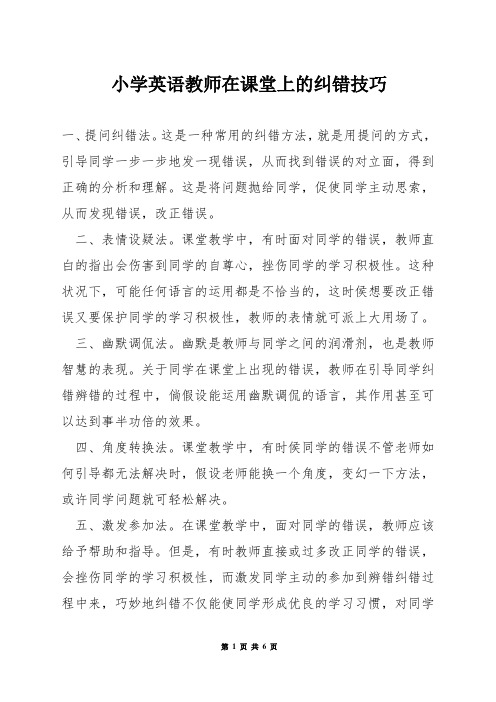
小学英语教师在课堂上的纠错技巧一、提问纠错法。
这是一种常用的纠错方法,就是用提问的方式,引导同学一步一步地发一现错误,从而找到错误的对立面,得到正确的分析和理解。
这是将问题抛给同学,促使同学主动思索,从而发现错误,改正错误。
二、表情设疑法。
课堂教学中,有时面对同学的错误,教师直白的指出会伤害到同学的自尊心,挫伤同学的学习积极性。
这种状况下,可能任何语言的运用都是不恰当的,这时侯想要改正错误又要保护同学的学习积极性,教师的表情就可派上大用场了。
三、幽默调侃法。
幽默是教师与同学之间的润滑剂,也是教师智慧的表现。
关于同学在课堂上出现的错误,教师在引导同学纠错辨错的过程中,倘假设能运用幽默调侃的语言,其作用甚至可以达到事半功倍的效果。
四、角度转换法。
课堂教学中,有时侯同学的错误不管老师如何引导都无法解决时,假设老师能换一个角度,变幻一下方法,或许同学问题就可轻松解决。
五、激发参加法。
在课堂教学中,面对同学的错误,教师应该给予帮助和指导。
但是,有时教师直接或过多改正同学的错误,会挫伤同学的学习积极性,而激发同学主动的参加到辨错纠错过程中来,巧妙地纠错不仅能使同学形成优良的学习习惯,对同学的能力培养也是很有帮助的。
课堂纠错的方法当然不只是以上所列的五种,更多的方法,必须要在施行中不断的去总结积存。
但每一次成功的纠错,老师们都必须要注意以下两点:一是把握纠错的契机。
二是要注意把握"度'。
一旦超越了这个"度',就有可能适得其反。
具体的操作则必须大家在施行中去把握应用了,就不是我能说清楚的了。
2小学英语教师如何上好英语课做足课前的备课工作。
包括重难点,如何导入,用什么方法,什么道具,心理都要有数,要有一份详尽的教案。
做好精美有趣的课件。
最好配上丰富的图片和美妙的歌曲。
注意上课的技巧。
要微笑进入教室,巡视整个教室的状况,用最有趣的方法导入到今天的课堂。
课堂要有条有序,重难点分明,按部就班。
初中英语课堂口语纠错的实践分析

初中英语课堂口语纠错的实践分析摘要:在仁爱版初中英语教材中,要求教师在课堂中重视学生综合能力以及学科素养的提升。
并且,在教材的内容中也更加的丰富、生动,能够满足现阶段初中学生的学习需求,此外,英语教材当中的口语学习也是非常的具有特点。
基于此,本文针对初中英语课堂口语纠错的实践分析进行简要阐述,以下仅供参考。
关键词:初中;英语;口语纠错引言:初中阶段的学生在英语课堂中普遍都会出现口语发音不准确以及语句词汇在表达方面的错误。
因此,怎样提升学生的英语口语成为了众多教师的一大难题。
英语口语是非常重要的学科表达工作,从而也是进行英语交流的主要方式之一。
在我国新课程不断改革的背景下,英语口语成为了英语教学的重中之重,对此,注重英语教师应当顺应时代的发展,走在时代的前沿,在传统的教学基础上进行创新,从而有效的提升学生的英语口语的表达嫩李,进一步促进学生的全面发展。
1.英语口语课堂教学的现状1.缺乏正确的语际理解当前,很多学校已经为英语口语开创了专门的课堂,让专业的英语口语教师对学生进行发音辅导。
学生在英语学习中出现问题的原因,有很大一部分的收到母语的影响。
因此,在口语练习期间,教师应当注重英语与母语当中的相同之处,对于类似的的内容,学生能够更加全面的掌握,但是,对于一些差异性比较多的问题,学生就会频频出现错误。
大部分的学生在英语口语表达期间,会通过母语的表达方式来进行逻辑的推理并且阐述。
例如,比较简单的一句,“你是谁”,在英语口语当中的表达方式,是“Who are you”,而通过母语逻辑的表达就是“谁是你”,这就是现阶段众多初中学生最常见的错误,这种现象的发生,在一定程度上限制了学生的英语口语表达,让很多学生成为了“哑巴英语”,想说又怕说错[1]。
1.缺乏主观意识的引导初中阶段的学生能处于青春期,这个期间的学生自尊心是非常脆弱,对于自己在英语表达方面所出现的错误,英语教师的批评以及学生的嘲笑,都会对这个学生的内心造成非常大的阴影。
高中英语课堂口语表达纠错技巧
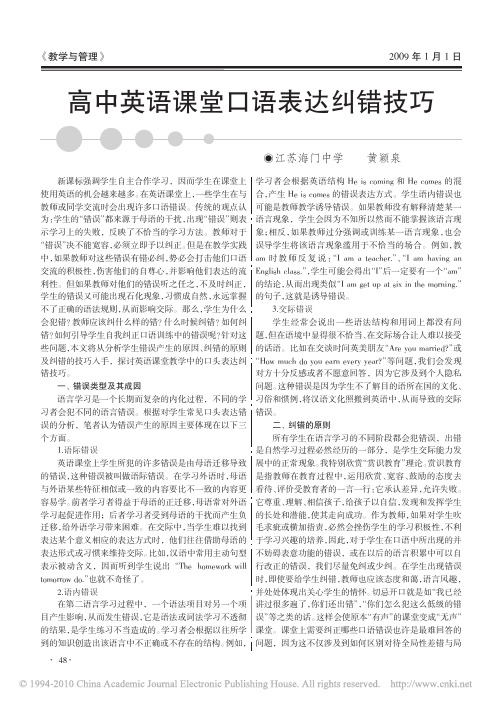
新课标强调学生自主合作学习,因而学生在课堂上使用英语的机会越来越多。
在英语课堂上,一些学生在与教师或同学交流时会出现许多口语错误。
传统的观点认为:学生的“错误”都来源于母语的干扰,出现“错误”则表示学习上的失败,反映了不恰当的学习方法。
教师对于“错误”决不能宽容,必须立即予以纠正。
但是在教学实践中,如果教师对这些错误有错必纠,势必会打击他们口语交流的积极性,伤害他们的自尊心,并影响他们表达的流利性。
但如果教师对他们的错误听之任之,不及时纠正,学生的错误又可能出现石化现象,习惯成自然,永远掌握不了正确的语法规则,从而影响交际。
那么,学生为什么会犯错?教师应该纠什么样的错?什么时候纠错?如何纠错?如何引导学生自我纠正口语训练中的错误呢?针对这些问题,本文将从分析学生错误产生的原因、纠错的原则及纠错的技巧入手,探讨英语课堂教学中的口头表达纠错技巧。
一、错误类型及其成因语言学习是一个长期而复杂的内化过程,不同的学习者会犯不同的语言错误。
根据对学生常见口头表达错误的分析,笔者认为错误产生的原因主要体现在以下三个方面。
1.语际错误英语课堂上学生所犯的许多错误是由母语迁移导致的错误,这种错误被叫做语际错误。
在学习外语时,母语与外语某些特征相似或一致的内容要比不一致的内容更容易学。
前者学习者得益于母语的正迁移,母语常对外语学习起促进作用;后者学习者受到母语的干扰而产生负迁移,给外语学习带来困难。
在交际中,当学生难以找到表达某个意义相应的表达方式时,他们往往借助母语的表达形式或习惯来维持交际。
比如,汉语中常用主动句型表示被动含义,因而听到学生说出“The homework will tomorrow do.”也就不奇怪了。
2.语内错误在第二语言学习过程中,一个语法项目对另一个项目产生影响,从而发生错误,它是语法或词法学习不透彻的结果,是学生练习不当造成的。
学习者会根据以往所学到的知识创造出该语言中不正确或不存在的结构。
谈英语课堂教学中的纠错艺术
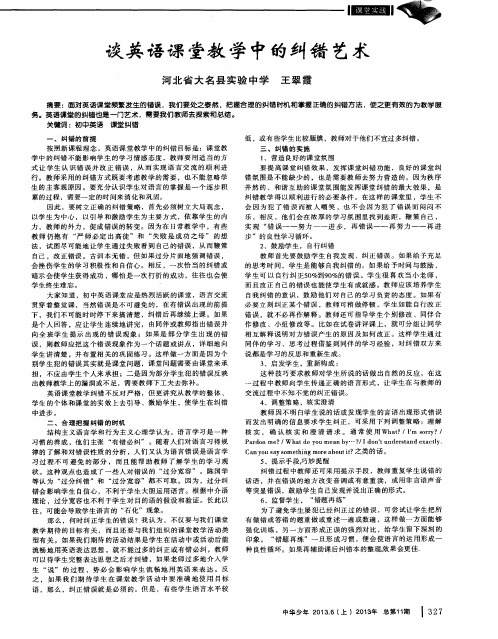
交 流过程 中不 知不觉 的纠正错 误 。 4 、调整策 略 ,核 实澄 清
一
课堂 纠错 低 ,或有 些学生 比较 腼腆 ,教 师对 于他们 不宜过 多纠错 。
三 、纠错 的 实施 1 、营造 良好 的课 堂氛 围
纠 错 的 前 提 按 照新 课程理 念 ,英 语课 堂教学 中 的纠错 目标 是 :课 堂教
、
学 中 的纠错 不 能影 响学 生 的学 习情 感 态度 ,教 师要 用适 当的方 式 让 学 生认 识错 误并 改 正 错 误 ,从 而 实 现 语 言 交 流 的顺 利进 行 。教 师采 用 的纠 错方 式 既要 考虑 教 学 的需要 ,也 不 能忽 略学 生 的主 客观 原 因 。要充 分认 识 学生 对语 言 的掌 握是 一 个逐 步 积 累 的过程 ,需 要一定 的时 间来 消化和 巩 固。 因此 ,要树 立 正确 的纠错 策略 ,首 先必 须树立 大局 观念 , 以学 生 为 中心 ,以引导 和 激励 学生 为 主要 方式 ,依 靠学 生 的 内 力 ,教 师 的外力 ,促成 错 误 的转变 。 因为 在 日常教 学 中 ,有些 教师仍抱有 “ 严 师 必定 出 高徒 ” 和 “ 失 败 是 成 功 之母 ” 的想 法 ,试 图尽 可 能地 让学 生 通过 失败 看 到 自己 的错误 ,从 而鞭策 自己 ,改 正错误 。古训 本 无错 ,但 如果 过 分片 面地 强 调错 误 , 会挫 伤 学 生 的学 习 积极 性 和 自信 心。相 反 ,一 次恰 当的 纠错或 暗示 会 使学 生 获得 成功 ,哪怕 是 一次 打折 的 成功 ,往往 也 会使 学 生终 生难忘 。 、
初中英语课堂如何加强口语纠错教学
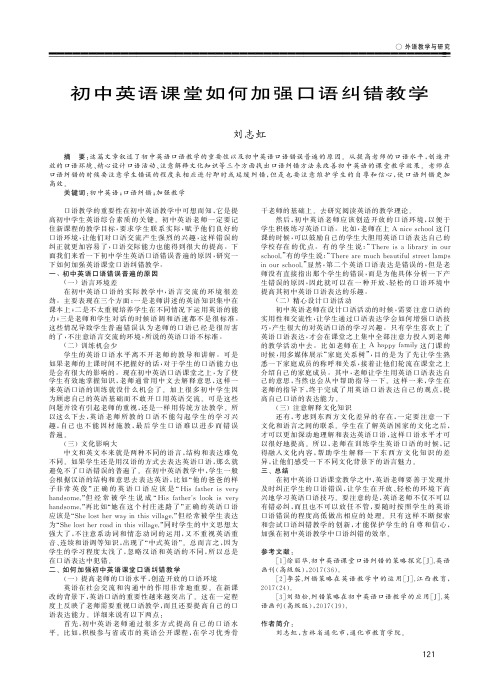
干老师的基础上.去研究阅读英语的教学理论. ,以 便 于
学生积极练习英语口语.比如,老师在上 Aniceschool这 门 课的时候,可以鼓励自己的学生大胆用英 语 口 语 表 达 自 己 的 学校存在 的 优 点. 有 的 学 生 说:“Thereisalibraryinour school.”有 的 学 生 说 :“Thereare muchbeautifulstreetlamps inourschool.”显 然,第 二 个 英 语 口 语 表 达 是 错 误 的,但 是 老 师没有直接指出那个学生的错误,而是为 他 具 体 分 析 一 下 产 生错误的原因,因此 就 可 以 在 一 种 开 放、轻 松 的 口 语 环 境 中 提高其初中英语口语表达的乐趣.
初中英语课堂如何加强口语纠错教学
刘志虹
摘 要:这篇文章叙述了初中英语口语教学的重要性以及初中英语口语错误普 遍 的 原 因. 从 提 高 老 师 的 口 语 水 平,创 造 开 放的口语环境、精心设计口语活动、注意解释文化知识等三个方面找出口语纠错方法 来 改 善 初 中 英 语 的 课 堂 教 学 效 果. 老 师 在 口语纠错的时候要注意学生错误的程度来 相 应 进 行 即 时 或 延 缓 纠 错,但 是 也 要 注 意 维 护 学 生 的 自 尊 和 信 心,使 口 语 纠 错 更 加 高效.
(一 )语 言 环 境 差 在初中英 语 口 语 的 实 际 教 学 中,语 言 交 流 的 环 境 很 差 劲.主要表现在三个方面:一是老师讲 述 的 英 语 知 识 集 中 在 课本上;二是不太重视培养学生在不同情 况 下 运 用 英 语 的 能 力;三是老师和学生 对 话 的 时 候 语 调 和 语 速 都 不 是 很 标 准. 这些情况导致学生普遍错误认为老师的口语已经是很厉害 的 了 ,不 注 意 语 言 交 流 的 环 境 ,所 说 的 英 语 口 语 不 标 准 . (二 )训 练 机 会 少 学生的英语口语水平离不开老师的教导和讲解.可是 如果老师的上课时间不把握好的话,对于 学 生 的 口 语 能 力 也 是会有很大的影响的.现在初中英语 口 语 课 堂 之 上,为 了 使 学生有效地掌握知 识,老 师 通 常 用 中 文 去 解 释 意 思,这 样 一 来英语口语的训练就没什么机会了.加上很多初中学生因 为顾虑自己的英语基础而不敢开口用英语交流.可是这些 问题并没有引起老师的重视,还是一 样 用 传 统 方 法 教 学. 所 以这么下去,英 语 老 师 所 教 的 口 语 不 能 勾 起 学 生 的 学 习 兴 趣,自 己 也 不 能 因 材 施 教,最 后 学 生 口 语 难 以 进 步 而 错 误 普遍. (三 )文 化 影 响 大 中文和英文本来就是两种不同的语 言,结 构 和 表 达 难 免 不同.如果学生还是用汉语的方式去 表 达 英 语 口 语,那 么 就 避免不了口语错误的普遍了.在初中 英 语 教 学 中,学 生 一 般 会根据汉语的结构和 意 思 去 表 达 英 语,比 如 “他 的 爸 爸 的 样 子非 常 英 俊 ”正 确 的 英 语 口 语 应 该 是 “Hisfatherisvery handsome.”但 经 常 被 学 生 说 成 “Hisfather���s��� lookisvery handsome.”再比如“她 在 这 个 村 庄 迷 路 了”正 确 的 英 语 口 语 应该是“Shelostherwayinthisvillage.”但 经 常 被 学 生 表 达 为“Shelostherroadinthisvillage.”同 时 学 生 的 中 文 思 想 太 强大了,不注意系动 词 和 情 态 动 词 的 运 用,又 不 重 视 英 语 重 音、连续和语调等知识,出现了“中式 英 语”. 总 而 言 之,因 为 学生的学习程度太 浅 了,忽 略 汉 语 和 英 语 的 不 同,所 以 总 是 在口语表达中犯错. 二 、如 何 加 强 初 中 英 语 课 堂 口 语 纠 错 教 学 (一 )提 高 老 师 的 口 语 水 平 ,创 造 开 放 的 口 语 环 境 英语在社会交流和沟通中的作用非常地重要.在新课 改的背景下,英语口语的重要性越来 越 突 出 了. 这 在 一 定 程 度上反映了老师需要重视口语教学,而且 还 要 提 高 自 己 的 口 语表达能力.详细来说有以下两点: 首先,初中 英 语 老 师 通 过 很 多 方 式 提 高 自 己 的 口 语 水 平.比如,积极参与 省 或 市 的 英 语 公 开 课 程,在 学 习 优 秀 骨
- 1、下载文档前请自行甄别文档内容的完整性,平台不提供额外的编辑、内容补充、找答案等附加服务。
- 2、"仅部分预览"的文档,不可在线预览部分如存在完整性等问题,可反馈申请退款(可完整预览的文档不适用该条件!)。
- 3、如文档侵犯您的权益,请联系客服反馈,我们会尽快为您处理(人工客服工作时间:9:00-18:30)。
B
8
3. 强调法(Pinpointing)
教师重复学生的话,有意重读和拖长出错部分的发音或用升调以 表示特别强调。
S: I am going in Beijing. T: I am going IN (?) Beijing? S: I am going to Beijing.
4. 启发法(Elicitation)
to work by a car…by car. She likes travel…traveling.
B
12
There are long trees on each side of my street.
B
5
2、区别对待系统性差错与语误 系统性差错是指学习者尚未掌握或尚未完全掌握目的语的
体系而出现的错误,也被称作语言能力错误。
• The girl dreamed to become a famous singer .
• S2: And you confused do and does here, too.
三、纠错技巧
1. 直接纠错法(Explicit correction) 2. 直接纠错是指学习者出现错误时,教师打断其语言训练或实践活 3. 动,对其错误予以正面纠正(说出正确的语言形式,并让学生改正
课堂用语通常有:You should say… / No, you shouldn't say that. / Read after me. / Pay attention to… / Oh, you mean… / We don’t say…in English. We say…等。
T: Well, please say something about your aunt.
S: OK. My aunt is a pretty long…tall woman. He…she is
a…an accountant.
She work…works on…in a car factory. She usually go…goes
3纠错方式
自我纠正(Self-correction)、 同学纠正(Peer-correction) 教师纠正(Teacher-correction)
B
• S1: What time do she usually do his homework? You confused his and her.
目产生影响,从而发生错误,它是目的语 错误或不完整学习的结果
例: He is coming. He comes.
生成错误: He is comes.
B
3
3、诱导错误(Induced errors)
教师讲授或学生练习不当造成的语言错误,主要表现 为教学诱导错误
例如,I am a teacher I am having an English class.
SS: Three baskets of apples. T: Yes. Good. Well done. OK(转向犯错的学生), do you understand?
B
9
5、重复法(Repetition) 教师发现学生的语言错误后,可以要求学生重新回答, 并使用Once more. / Pardon? / Repeat please.等对学 生加以引导。如:
全局性错误指使用句子结构主要成分中出现的错误,导致句子 或话语难以理解或无法理解
I like take taxi but my friend said so not that we should be late for school.
语序颠倒、错用或漏用连接词、句法过度概括 局部性差错是指句子结构成分运用中出现的错误,但没有造成理 解问题
when I was in bed.
B
10
6、追问法(Pumping) 当学生没能准确回答问题而又未犯语法错误时,教师应
鼓励学生继续回答,直到他/她做出更合理的、更符合逻辑 的回答。例如:
T: Who told you the news? S: The sports meet will be held in our city next summer. T: Good, but who told you the news, Mary or Mike? S: Mary told me the news.
英语课堂口语纠错技巧
一、错误类型及其成因
二、纠错的原则 三、纠错技巧 四、纠错案例评析
B
1
一、错误类型及其成因
• 1、语际错误 母语迁移导致的错误。
The problem will discuss tomorrow”
分析:汉语中常用主动句型表示被动含义 而英语中必须体现被动语态。
B
2
• 2语内错误 一个目的语项目对另一个项
I am get up at six in the morning.”
4、交际错误
,
语法结构和用词上都没有问题,但在语境中显得很不恰当
在交际场合让人难以接受
“Are you married?”
或“How much do you earn every year?”
B
4
二、纠错的原则
• 1、区别对待全局性差错与局部性差错
教师通过以下方式启发学生纠正错误:
T: Now, look at this picture. What’s in it? S1: Three basket of apples. T: Three basket of apples? Is he right?(用目光或手势示意全班学生回答)
OK. Please correct it.
B
7
T: What did you have for breakfast this morning? S: I have a bottle of milk, an egg and two cakes. T: Oh. You should say“I had a bottle of milk…”Read after me,
7、澄清法(Clarification requests)
教师因不明白学生说的话或发现学生的言语出现形
式错误而发出明确的信息要求学生纠正,通常使用What?
/ I’m sorry? / Pardon me? / What do you mean by…?之
类的话。
B
11
S: I want be a scientist when I grow up. T: Er? I’m sorry? I want…
• S: I made my birthday cake last night when I was in bed.
• T: Er? Who made your birthday cake? Once more.
• S: My mother. • T: Oh, your mother. And then repeat it please. • S: My mother made my birthday cake last night
please. S: Oh, sorry. I had a bottle of milk, an egg and two cakes.
2. 重述法(Recasts) 重述是指教师对学生语言表达中的错误进行含蓄纠正。
• S: I think that the worm will go under the soil.(第一次表达) • T: I think that the worm will go under the soil? • S: …(没有回答) • T: I thought that the worm would go under the soil.(重述) • S: I thought that the worm would go under the soil.(第二次表
S: I want to be a scientist when I grow up.
8、等待法(Waiting) 有些口语错误只是语误而已。在听到学生的语误时,教师应
尽可能延长等待时间,让学生自行纠错(James, 2001)。学生发 言时,教师最好不要打断学生。必要时,可以使用一些表示不认可 或困惑等的体态语或简短的提示语,以帮助学生意识到错误并进行 自我纠正。例如:
